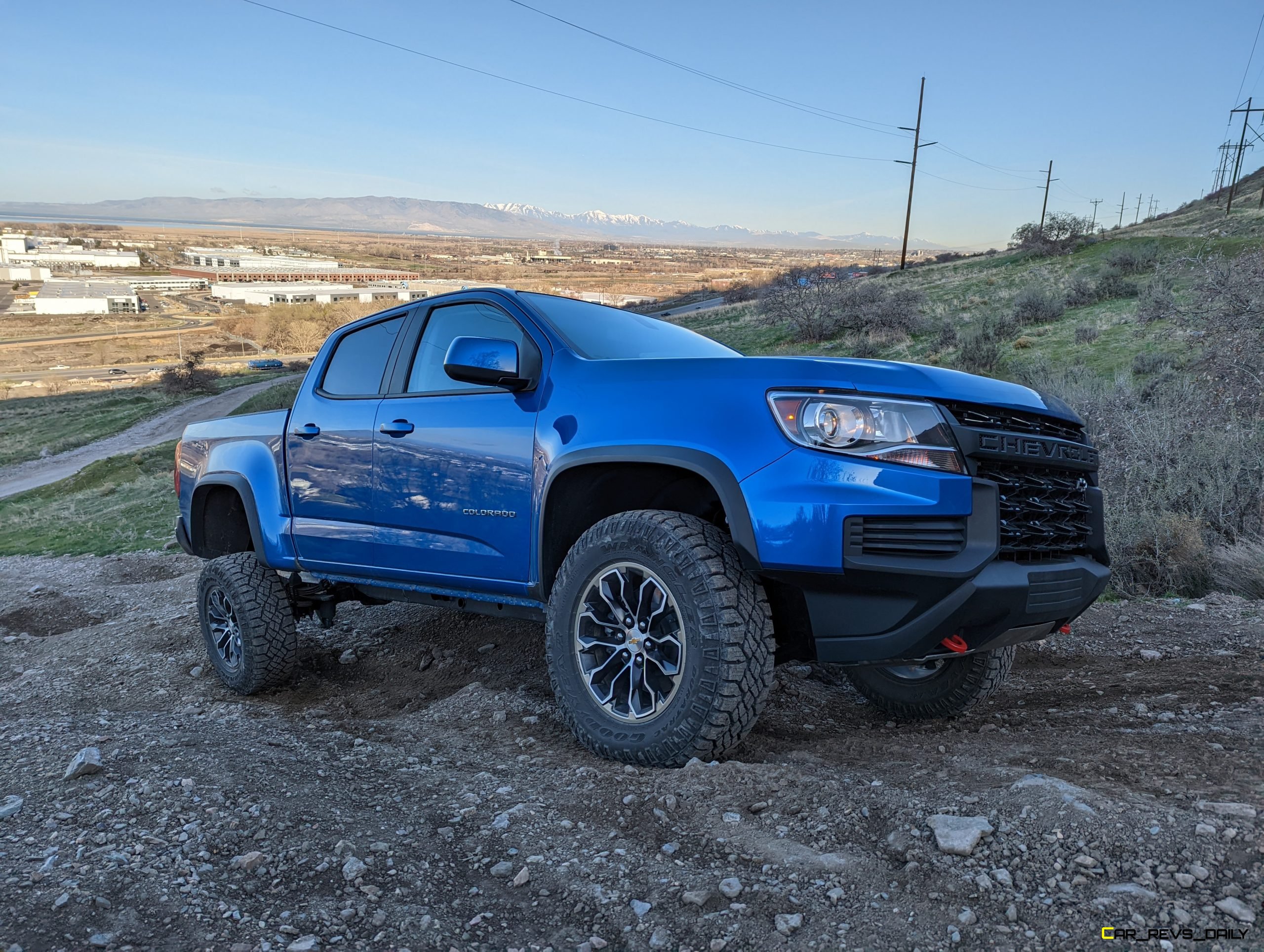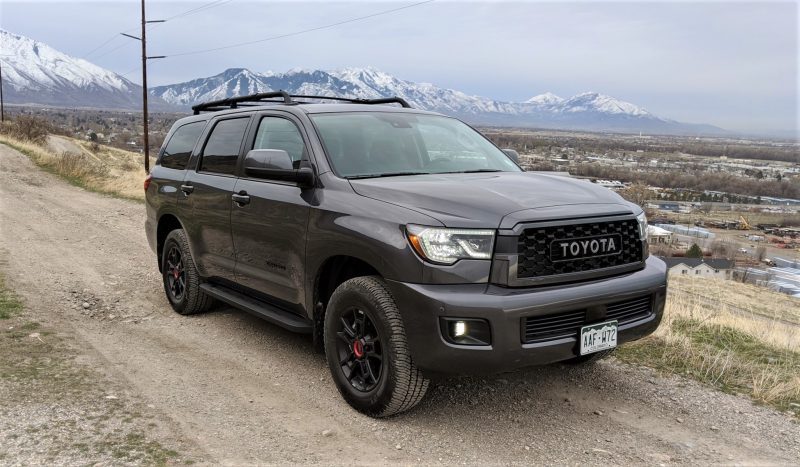Like nearly all other body-on-frame vehicles Toyota makes, the Sequoia is getting old. The current generation came out for the 2008 model year. Of course, there have been updates here and there over time, but there hasn’t been a major redesign in 12 years.
For 2020, Toyota has introduced the TRD Pro trim level to the Sequoia. Like all other TRD Pro vehicles, the Sequoia has upgraded suspension components and a few unique color and trim items.
Exterior
No matter how you look at it, the Sequoia is a beast. Nearly everything about it is big. The front greets you with a large black grill with bold TOYOTA lettering across the center. LED headlights adorn the sides of the grill, with LED daytime running lights forming brackets that tie everything together nicely. The opening in the bumper provides for additional cooling and adds to the grill’s large look. Placed in the corners of the bumper are Rigid Industries LED fog lights. Interestingly enough, you can turn on these fog lights without the headlights being on, which can’t be done in some other Toyota vehicles.
Moving to the side, the enormous features continue. Both the front and rear doors are very large which makes getting into any seat easy. The Raptor-esque aluminum steps run from wheel to wheel and feel very sturdy. However, they are mounted to the body, not the frame. This means when off-road they can take small hits, but large hits are likely to damage something. Due to the massive size of the Sequoia, the 32-inch Michelin LTX AT2 tires almost look a little small. The Black 18-inch rims are the same as the ones used on the Tundra TRD Pro and Land Cruiser Heritage Edition, but they are painted a different color for the Land Cruiser. Also noticeable from the side is the sizeable roof rack. The roof rack isn’t a, dare I use the word, overland style rack. It does have three crossbars with adjustable positions to make securing items to the roof a breeze.
Heading to the rear of the Sequoia, the giant proportions continue. The taillights consist of four large circles reminiscent of older Corvettes. There is a Class IV receiver hitch and 7-pin plug for towing trailers, however there is no standard or optional trailer brake controller. Some manufacturers are finally starting to offer trailer brake controllers in their larger SUVs, and we believe that it should be available on all body on frame vehicles. New are a couple of buttons on the back of the liftgate that allow the rear window to be opened from the outside. We love the fact that the giant rear window rolls all the way down into the rear hatch. More SUVs and trucks should implement windows like this.
Interior
Inside the Sequoia is just as immense as the outside. For the TRD Pro, seven leather trimmed seats are standard. Sorry for those looking to haul eight people while heading to the rough stuff as there is no eight seat option for the TRD Pro. The updated 7” screen and premium JBL 14 speaker audio system are both greatly improved from past years and are also standard on the TRD Pro. Apart from tight parking stalls, the only thing we disliked about the colossal features of the Sequoia was the infotainment system. The tune knob is so far from the driver that it requires a significant amount of lean to reach. It’s a very uncomfortable stretch.
Access to the third-row seats is very easy. Getting there can be done by going through the middle of the second-row seats or by tilting and sliding a second-row seat forward out of the way. The second-row seats can slide forward even when loaded with a car seat. Even with the second-row seats all the way back, there is enough room for adults to fit in the third row. Sliding the seats forward a few inches does help with third row leg room without hurting the second row too much.
The cargo area is still large enough to carry groceries and a few other items when all the seats are up. With all the seats folded down, it might be possible to fit a 4×8 sheet of material in the back. In order to do so though, the front seats would have to be slid quite far forward, making the driver and passenger uncomfortable, if they even fit. We wouldn’t recommend doing that, but it does seem possible.
On-Road
Driving the Sequoia TRD Pro on-road was quite pleasant. The TRD tuned Fox suspension eats up potholes and bumps with ease. The potential issue here is that driving over a speed bump at higher speeds isn’t a problem, rendering them useless.
Going through tight, twisty canyon roads is a little more unsettling though. The suspension is tuned very well for rough gravel roads but leans a bit on tight pavement turns. If you’re looking for a pavement Sequoia, consider the TRD Sport that has stiffer anti-sway bars and suspension-tuning designed for the road.
Our test model was equipped with the optional TRD performance exhaust system. This gave the exhaust a deep, throaty V8 burble, but it droned at almost any speed. It was bad enough that a child in the third-row seat screamed “Make it stop!” We would forgo this $1050 option.
Off-Pavement
Like all other TRD Pro vehicles, off-pavement is where the TRD Pro Sequoia really shines. The suspension has been tuned for high speed gravel and rough road travel. The front shocks are 2.5-inch, and rears are 2-inch with both having internal bypass and piggyback reservoirs. These large diameter shocks with additional reservoirs stay cool and don’t fade with heavy use.
The Sequoia is equipped with four-wheel independent suspension, which limits wheel articulation, but makes cruising at high speeds over rough terrain a breeze. The TRD Pro suspension does allow for an extra half-inch of wheel travel both front and rear over all other Sequoias. This helps at both high and low speeds when off-road. We never felt the suspension bottom out on our rough road section, which has happened in other vehicles.
When crawling over rocks or lifting a wheel, A-TRAC works very well to transfer power where it needs to be. The Sequoia has a Torsen limited slip center differential with an electric locker. This gives the Sequoia AWD capabilities in both 4WD high and 4WD low. With the center differential not locked, you can drive on pavement without any tire scrubbing or driveline binding, but when you need the extra traction you can lock the center differential.
One thing that could use some improvement is downhill driving. The crawl ratio on the Sequoia is too high, and even when locking it in first gear while descending steep grades, the engine braking isn’t enough to keep the speeds safe. There is no downhill assist or crawl control feature in any versions of the Sequoia. We never felt out of control, but during our testing there were times when one or more wheels would lock up causing the vehicle to slide sideways while descending.
Pricing
The TRD Pro trim comes standard with a lot of features, and as such our test model only had three options; the $245 cargo cover, the $1050 performance exhaust, and the $379 floor mats. With a base price of $64,030 and a delivery charge of $1,325, this brought the total to $67,029.
Conclusion
Overall, we loved the Sequoia TRD Pro. The amount of space is incredible, the driving manners are great for a vehicle this big, it has a towing capacity of over 7,000 pounds, and it can easily travel forest service and fire roads. The base price includes plenty of features and no additional items are necessary. Like all other TRD Pro vehicles, if you’re planning to do extensive modifications it’s better to start with a different trim level, but if you’re wanting to have a capable factory equipped machine then the Sequoia TRD Pro is a great choice!

Matthew Barnes is an experienced towing expert. He works as a mechanical engineer and his day job involves testing a variety of vehicles while towing trailers of all types and sizes. Matt shares his knowledge by writing for automotive news outlets in the evenings. When he’s not working he can be found spending time in the great outdoors with his family. He enjoys camping, hiking, canyoneering, and backpacking. Whenever possible he spends time riding in or on any power sports vehicle he can find and claims he can drive anything with a motor, which probably isn’t true.
Matt lives in the Utah mountains and often posts cool off-roading videos to his Instagram and YouTube channel.


























































